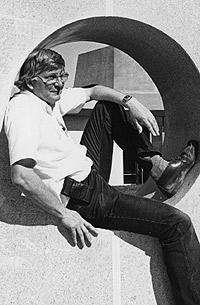Berkeleyan
Obituary
David Cudaback
![]()
24 August 2006
David Dill Cudaback, a senior lecturer emeritus in astronomy, died in his Oakland home July 23 after a long battle with Parkinson's disease. He was 77.
 David Cudaback |
Cudaback was known to decades of students for his enthusiasm and eagerness to share the wonders of astronomy. A hands-on course he developed in 1987 to teach the fundamentals of observational astronomy won an Educational Initiatives Award from the campus in 1995.
Another award, the Donald Sterling Noyce Prize for Excellence in Undergraduate Teaching, was given to Cudaback in 1994. The prize goes each year to a Berkeley faculty member in the physical sciences.
Cudaback was born Jan. 18, 1929, and raised in Napa, the younger of two boys helping with the family chicken ranch. At Napa High School he developed a keen interest in all things scientific and became the first student from Napa ever to win a National Westinghouse Science Foundation Scholarship.
Choosing to attend Berkeley, he began his career the summer after high school in a campus chemistry lab. He continued to work in various labs on campus while earning his undergraduate degree in physics, which he completed in 1951. After a year at Los Alamos Laboratory in New Mexico, he returned to Berkeley to pursue graduate studies, earning a Ph.D. in astronomy in 1962. He remained in the department, working over the course of 30 years as an experimentalist at visible, infrared, and radio wavelengths. After retiring in 1994, Cudaback taught as a volunteer for several years.
Cudaback's interest in the problems caused by the earth's atmosphere, which makes stars fuzzy, engendered a passion for high-altitude telescope sites that minimize atmospheric problems. As the world's largest telescope was being planned, he volunteered to scout out a high-altitude site in California's White Mountains. The 10-meter Keck Telescopes instead were built in Hawaii on top of a 13,790-foot volcano, Mauna Kea.
Cudaback's high-altitude observing allowed him to indulge another love: hiking in the mountains, mostly above timberline. There he also took the opportunity to study human response at high altitudes to low oxygen levels. He recommended that astronomers' work areas have a higher-than-normal fraction of oxygen, which anticipated the use today of oxygen pumps by those working at mountaintop observatories like Keck.
Cudaback's passion for astronomy also led to a collaboration with the late artist Richard O'Hanlon, a former Berkeley professor of art, on three sculptures incorporating planes and angles with astronomical significance. Sunstones I, which marks the height of the sun at noon at different seasons, was placed at the California Academy of Sciences in San Francisco.
The most visible astronomical sculpture, however, is Sunstones II, a 15-foot, 16-ton granite sculpture installed in 1979 outside the Lawrence Hall of Science. Sight lines Cudaback incorporated in O'Hanlon's piece allow visitors to see seasonal events such as the northern- and southernmost setting of the sun at the solstices; the northern- and southernmost setting of the moon in its 18-year cycle; and the northern- and southernmost settings of the planets in a cycle spanning tens of thousands of years. Cudaback and many friends gathered for a quarter-century at the sculpture to toast the sunset on winter solstice.
Cudaback was an active and devoted member of the Sierra Club, and he met his future wife in 1952 at a dance at the club's Donner Summit ski lodge. He also was a fellow of the California Academy of Sciences and of Oakland's Chabot Space & Science Center.
He is survived by his wife, Dorothy "Dot" Cudaback of Oakland; and daughter, Cynthia, of Raleigh, N.C. He had one grandson.
A memorial service was held Aug. 6. The family asks that friends make a small contribution to Friends of Berkeley Astronomy, c/o Astronomy Department, UC Berkeley, 601 Campbell Hall, Berkeley, CA 94720-3411, or to research on Parkinson's disease.
- Robert Sanders

